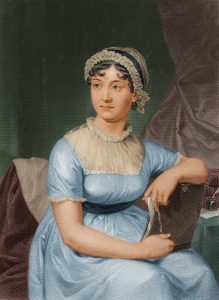My sweeties, those of you who know me a little bit, know that the reason I decided to become an author is one: Jane Austen!

Jane Austen is not only one of the most popular writers in the world, but also one of the most beloved of book lovers out there. You will find it hard to find anyone who has not read even one of her books. It’s just as hard to find someone who hasn’t seen one of their transfers to the cinema or television.
She has created heroes that cover a wide range—social, spiritual and cultural. Her characters are realistic and convincing, her heroines are bold, dynamic and determined, as opposed to the usual type of lady of that time.

Probably because Austen herself refused to fit into the context that society had placed women—being a writer was, in itself, a bold innovation. Her books portray realistically the whole of English society at the beginning of the 19th century.
A lot has been said and written about Jane Austen. However, little is known about who Jane really was…
I’m glad to have the opportunity to write a little bit about this unbelievably great author. Are you with me, my dearie? 😉
Born on December 16, 1775, in a small hamlet in Hampshire County, Steventon, she was the seventh child of English priest George Austen and Cassandra Lee. Her family, though prosperous, were not considered wealthy. Despite that, she grew up in a happy home that she never wanted to leave.

Jane, like every girl of her time, helped out at home, played the piano for half an hour before breakfast and devoured her father’s library. She loved reading novels, something she wrote later in her books!
Unlike her heroines, she never married and lived most of her life without experiencing many surprises.
Austen’s work began with Eleanor and Marianne—the heroines of a book that later took one of the most iconic titles in English literature and became a blockbuster, with Emma Thompson, Kate Winslet, and Hugh Grant. “Sense and Sensibility” was first released on October 1811, without the author’s name on the cover…just with a neat and fuzzy “By A Lady” to add extra mystery to the fact that another female voice made her appearance in English literature.

After that one, other novels followed: “Emma”, ”Mansfield Park”, “Persuasion”, “Northanger Abbey” and perhaps the most famous of all, “Pride and Prejudice”—one of the most iconic love stories ever told.
And that is how the most characteristic model of the ideal man in world literature was born. By this woman who lived her life without intense emotions and experiences, and without discovering the magic of great love herself.

The imposing and rigorous Mr. Darcy falls in love with Elizabeth Bennet, almost from the first moment he set his eyes on her. Mr. Darcy wants for himself, like a crazy man, what he advised his best friend (who was in love with Elizabeth’s sister) to avoid at all costs. To relate to her simplistic, coarse, unkempt on several occasions, family.
Her books are full of the daily life of a society far from us, yet they make us experience the era in such an alive and true way.

It is not absurd that the slogan “I blame Mr. Darcy for my high expectations on men” remains one of the most beloved in t-shirts and mugs in the UK.
We know little about Jane Austen’s love life. Although, since she was never married, she probably died a virgin, yet love was not missing from her life.
We know that in 1796 she had scandalized the small community of Steventon by flirting openly with Irishman Tom Lefroy, who had visited relatives and friends of the Austen family. Although his stay was short and their love convicted—since neither of them had the means to marry—we can say that Tom was the first love affair in Jane’s heart.

The movie “Becoming Jane” refers, with a Hollywood glance, to this incomplete bond. Her sister Cassandra, too, referred to her great love for a young Englishman around 1801, who eventually died.
Unfortunately on July 18, 1817, after a year of living with a painful illness (possibly some form of cancer), she died in Winchester, where she had relocated to be close to her beloved sister.
However, she did not stop writing throughout her illness. Even when she was too weak to hold the pen, she wrote in pencil. She left her final novel, Sanditon, unfinished; a book that included a satirical depiction of the fashionable seaside resort.
Her tomb is located at Winchester Cathedral with no mention of her authorship.

Jane Austen was, in her short but creative life, a talented writer who, in stubbornness to her family and the rigid social conventions of the Regency era, left us with six ‘classic’ novels.
Well, my sweetie, this is the end of my first article!
I hope you enjoyed it—I certainly did while writing it!
Thank you for accompanying me on my writing journey!
It would be lovely if you could share your thoughts with me! Or whatever you like…Surprise me!
Written by Violet Hamers

 Share this book
Share this book